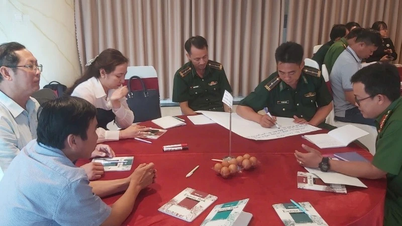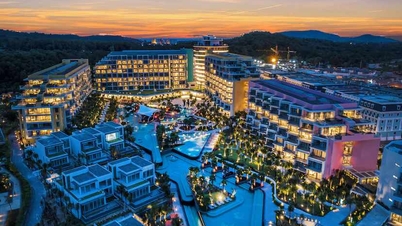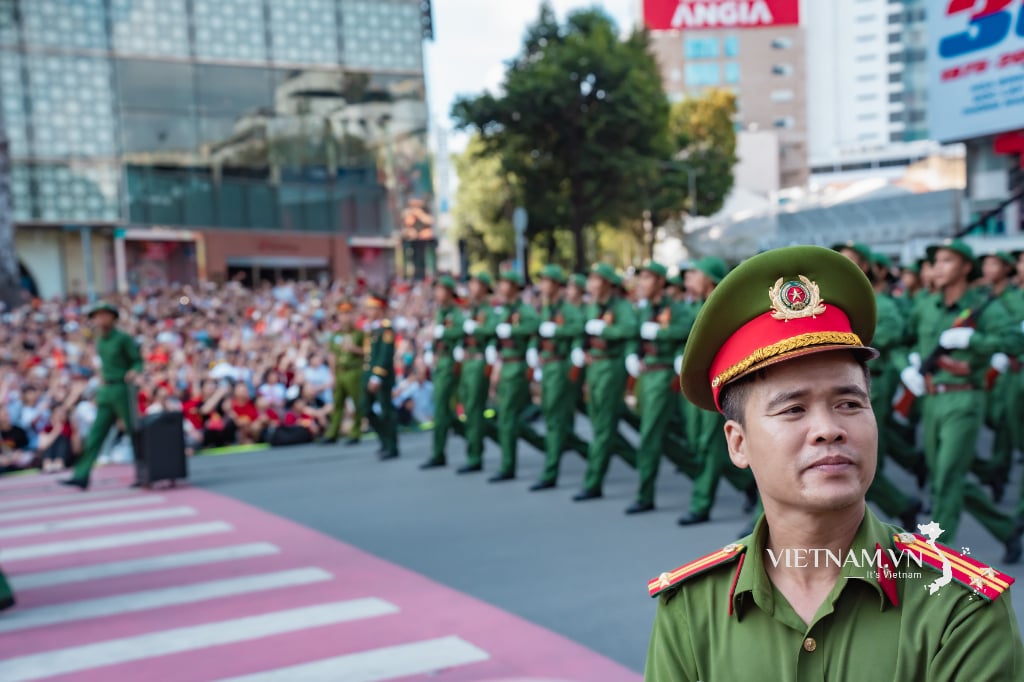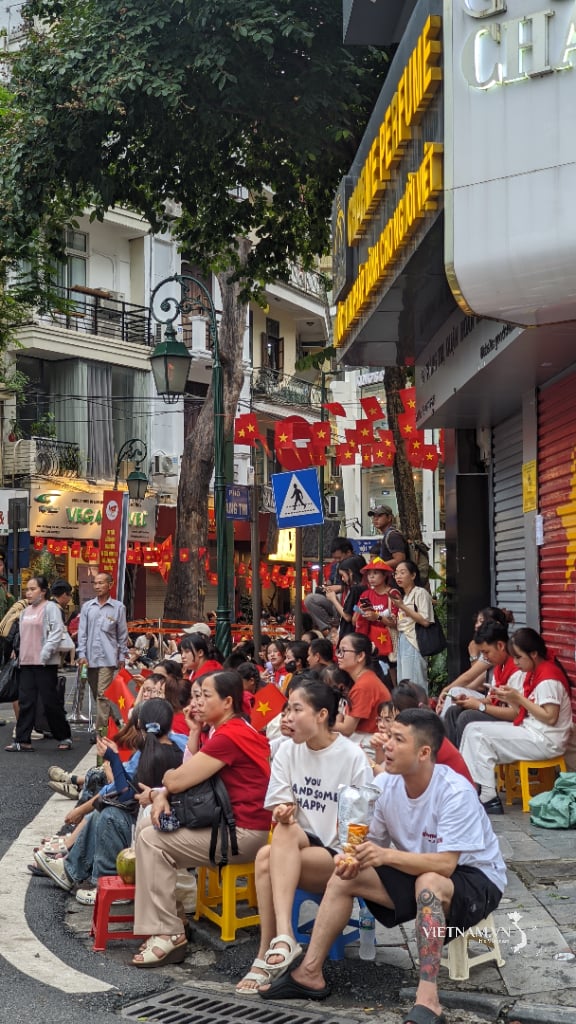Generations of "masters" in portraying Uncle Ho.
Like most people from all walks of life, the visual arts community quickly joined the ranks of artists and writers following President Ho Chi Minh's revolutionary path from the very beginning. A generation of renowned artists from the Indochina Fine Arts School, those who participated in the resistance, and talented artists passionately created works about him with deep admiration and respect, producing many famous pieces, such as: "President Ho Chi Minh in the Viet Bac War Zone" (lacquer painting, Duong Bich Lien - recognized as a National Treasure), "President Ho Chi Minh with Children" (woodcut, To Ngoc Van), "President Ho Chi Minh on a Mission" (silk painting, Nguyen Thu), "Tonight President Ho Chi Minh Doesn't Sleep" (woodcut, Nguyen Nghia Duyen), "President Ho Chi Minh's House at the Presidential Palace" (oil painting, Luong Xuan Nhi), "Portrait of President Ho Chi Minh" (oil painting, Tran Van Can), "President Ho Chi Minh Writing Poetry in Pac Bo" (sketch, Phan Ke An)...
The first person to paint a portrait of President Ho Chi Minh directly amidst the vibrant revolutionary atmosphere of Hanoi in October 1945 was Van Giao (1916-1996), one of the first generation of revolutionary Vietnamese painters, who dedicated his entire life to depicting the image of Uncle Ho.
Having had the opportunity to interact directly with Uncle Ho; having lived and painted in places where Uncle Ho lived and worked, such as his hometown in Nghe An, Pac Bo, Cao Bang ...; using a highly expressive and expressive painting method, Van Giao's works about Uncle Ho touched the hearts of many Vietnamese people, leaving a deep mark on revolutionary art. These works include: Portrait of President Ho, Uncle Ho writing the Declaration of Independence, Uncle Ho visiting his hometown...
The history of Vietnamese art forever records the touching story of a young man from the South, artist and sculptor Diep Minh Chau (1919-2002), who painted a portrait of President Ho Chi Minh with his blood after the August Revolution. He was fortunate enough to obtain a small photograph of President Ho Chi Minh cut from a newspaper, which he carefully kept in his wallet, placed in his left breast pocket near his heart; from then on, he painted President Ho Chi Minh wherever he went.
Born in Ben Tre , when the resistance war against French colonialism broke out, Diep Minh Chau joined the revolution and wrote about the life and struggles of the people and soldiers of Southern Vietnam. Before that, on the second anniversary of the founding of the nation on September 2nd, 1947, he pricked his hand to paint a picture of President Ho Chi Minh with three children from the North, Central, and South regions on silk, which he sent as a gift to President Ho Chi Minh; accompanied by heartfelt letters expressing his gratitude to "Father Ho" for liberating his art and leading him to a revolutionary life...
In mid-1950, Diep Minh Chau went to Viet Bac to take on a new assignment. Fortunately, he had the opportunity to live near President Ho Chi Minh, and he meticulously studied his appearance and character. He devoted all his efforts to researching and expressing these qualities, resulting in a series of representative works such as "The Layout of President Ho Chi Minh's House on the Hill" (silk), "President Ho Chi Minh Working in a Stilt House in Viet Bac" (oil painting), "President Ho Chi Minh Fishing by the Stream" (oil painting), and "Midday Sunlight in Front of President Ho Chi Minh's House" (oil painting).
In particular, he created many statues of President Ho Chi Minh, including a bronze statue of President Ho Chi Minh with children (placed in front of the Ho Chi Minh City People's Committee headquarters on the occasion of the 100th anniversary of President Ho Chi Minh's birth).
Diep Minh Chau is a sculptor belonging to the first generation of revolutionary and modern Vietnamese sculpture, and also the only sculptor to be awarded the first Ho Chi Minh Prize (1996) for a collection of works, mostly about President Ho Chi Minh: Painting of President Ho Chi Minh and children from North, Central, and South Vietnam (painted with blood on silk - 1947); President Ho Chi Minh by Lenin Stream (plaster - 1980); President Ho Chi Minh with children (bronze statue - 1993).
Throughout the revolutionary journey, the struggle for national liberation, and the building of the nation, the image of President Ho Chi Minh has been realistically and vividly portrayed by artists in many genres, with a variety of materials. Although the brushstrokes and creative styles differ, the works all express the simplicity, nobility, and radiant beauty of his thoughts, ethics, and style.
Continuing the creative flow
Following in the footsteps of their predecessors, later generations of artists continued the creative flow of Ho Chi Minh's work, but mostly in the genre of propaganda paintings, printed using computer graphics, and created based on documentary materials with themes such as: Uncle Ho with children, soldiers, workers, farmers... It can be seen that in recent times, there haven't been many young artists creating works about Uncle Ho, facing difficulties because they haven't been able to directly paint him but have to draw inspiration from documentary materials, using more graphic language and less visual language,...
In this context, the field of sculpture continues to see exploratory efforts from a number of young talents, including sculptors Le Lang Luong and Khong Do Tuyen, lecturers at the Vietnam Fine Arts University, and their collaborators.
Le Lang Luong said that he rarely accepts projects to create statues of President Ho Chi Minh if he doesn't see a suitable and impressive idea. He has participated in many monument projects about President Ho Chi Minh, including some large-scale award-winning works such as: the statue of President Ho Chi Minh with the ethnic groups of the Central Highlands, President Ho Chi Minh with the people of the ethnic groups of Tuyen Quang province..., but the two works he is most proud of are the statue of President Ho Chi Minh at the Kim Lien Historical Site Exhibition Hall, Nam Dan, Nghe An (2021) and the statue of President Ho Chi Minh in Tan Trao currently under construction, expected to be completed on August 19th.
The artwork depicting Uncle Ho in the Kim Lien Historical Site Exhibition Room is of moderate size (1.9m high) and made of bronze. During his life, Uncle Ho visited his hometown twice: the first time in 1957, and the second and final time in 1961. When he left, his homeland was still under colonial rule; upon his return, he was the President of the country, a free citizen, and also an old man returning to stand before his family's ancestral altar, only to find his parents, siblings, and relatives gone. From this special emotion, the artist portrays Uncle Ho holding a cigarette, his face and eyes filled with tears, his steps heavy with suppressed thoughts and emotions...
These days, the statue of President Ho Chi Minh in Tan Trao, led by team leader Le Lang Luong, is being urgently constructed and is expected to be placed in the square of the Tan Trao National Special Historical Site, Tuyen Quang province, on August 19th to commemorate the 80th anniversary of the Tan Trao National Congress.
The 7.5-meter-tall (12-meter total height) bronze statue depicts President Ho Chi Minh in a special context: his stay at the Na Nua hut in July 1945 – a moment when he faced a crucial decision, demonstrating the will and determination of the Party and the nation to carry out the August Revolution to seize power (President Ho Chi Minh told General Vo Nguyen Giap: "Now the opportune moment has arrived; no matter what sacrifices we have to make, even if we have to burn down the entire Truong Son mountain range, we must resolutely fight to achieve independence..."). During this time, President Ho Chi Minh's health was very weak, and it seemed he might pass away.
The circumstances created an interesting but challenging sculptural angle. With creative inspiration drawn from many directions (hearing stories, researching documents, visiting places where Uncle Ho lived, imagination...), the artists ultimately explored and used a unique sculptural language to depict the image of a simple "revolutionary old man" with an indigo-dyed shirt, a scarf draped over his shoulder, thin but still sharp-witted and dignified...
Le Lang Luong shared that the challenge in creating the statue of President Ho Chi Minh lies in the fact that many predecessors have already succeeded, so he had to strive to find something unique, to have new creative elements, and to make an impression. And his efforts, along with those of his colleagues, have brought unique and expressive features to the image of President Ho Chi Minh.
According to artist Luong Xuan Doan, President of the Vietnam Fine Arts Association, Vietnamese fine arts are currently undergoing a generational transition in the creation of works about President Ho Chi Minh; sculpture of statues of Uncle Ho continues its tradition with efforts to explore and experiment. Recently, a new feature of projects involving statues and monuments of Uncle Ho is that the Art Council now includes more professionals than before; directly selecting and inviting authors with significant contributions and expertise in this subject matter, instead of organizing design competitions as in the past. Therefore, the projects are simpler, more streamlined in procedures, and of higher quality.
On the occasion of the 135th anniversary of President Ho Chi Minh's birth, the monument commemorating President Ho Chi Minh's visit to his hometown, created by sculptors Le Lang Luong, Khong Do Tuyen, and their collaborators, has just been unveiled. It is located at Lang Sen Stadium, within the Ho Chi Minh Memorial Area in Kim Lien commune, Nam Dan district, Nghe An province. The monument is large (the statue itself is 7.9m high) and cast in bronze using modern technology, depicting President Ho Chi Minh in a simple yet emotional state during his visit to his hometown in 1961.
Over the past period, the Ministry of Public Security has spearheaded the construction of several statues of President Ho Chi Minh as gifts to various localities and units. Along with the statue of President Ho Chi Minh visiting his hometown in Nghe An, the statue of President Ho Chi Minh in Tan Trao is also being urgently completed to be presented to Tuyen Quang province on August 19th, commemorating the 80th anniversary of the Tan Trao National Congress; and the statue of President Ho Chi Minh commemorating the nation's festival will continue to be made for Phu Tho province on the occasion of the Hung Kings' Commemoration Day in 2026,...
Monuments dedicated to President Ho Chi Minh not only possess unique historical, cultural, and architectural value, but also serve as significant landmarks to honor and commemorate his contributions, and to educate future generations about revolutionary traditions.
Source: https://nhandan.vn/tiep-noi-mach-nguon-sang-tao-ve-bac-post880669.html





































































































Comment (0)